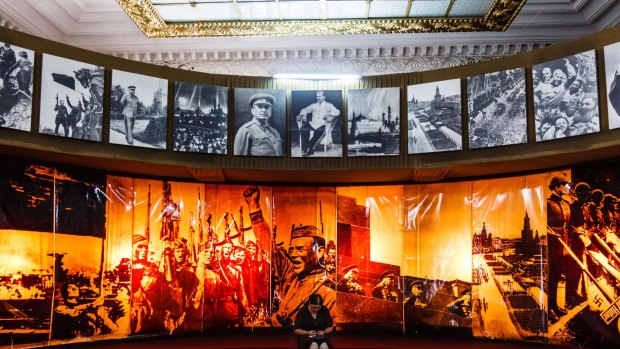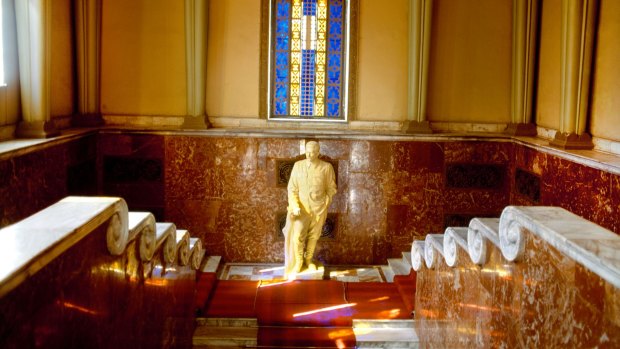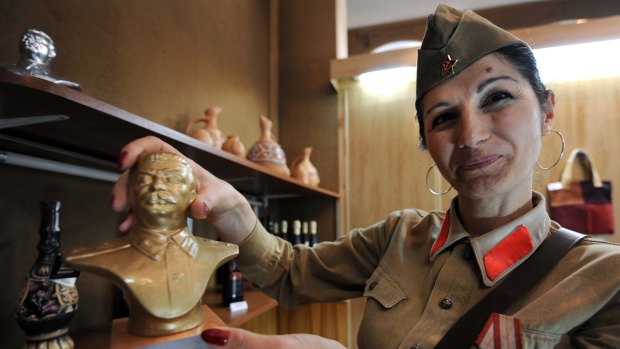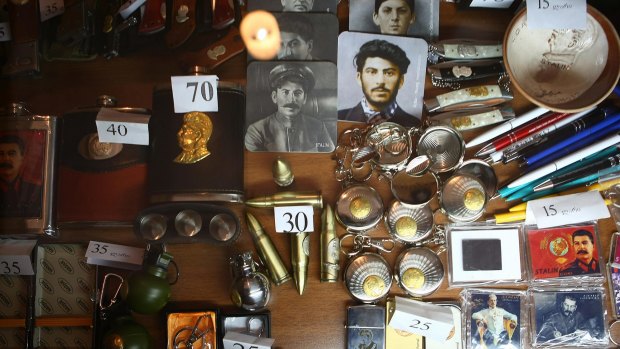This was published 9 years ago
Gori, Georgia: Stalin museum gets a makeover
By Michael Gebikci

Whitewash: In the Stalin Museum. Just don't mention the gulags.Credit: Alamy
Stalin himself might not appreciate the comparison, but when I enter the museum dedicated to him in his birthplace in the town of Gori in central Georgia, it feels like I'm in a church. I'm standing in a vaulted archway with a set of wide marble stairs at the end, leading upwards to a statue of Stalin standing beneath a stained glass window. The image is unmistakeably godlike. The atmosphere is hushed, and reverence hangs in the air, in homage to Georgia's most famous son.
Like a nightmare, the disintegrating jigsaw that was once the Soviet Union has shrugged off memories of Joseph Stalin. His statues have been heaved down and melted, Stalingrad is now Volgograd and Stalin's pickled cadaver, which once lay alongside Lenin's in Red Square, was removed in 1961 and shoved into the Kremlin wall. Which makes the Stalin Museum in his hometown a historical curiosity, an artefact left behind by a receding tide.
Upstairs, past Stalin's statue, the museum's first exhibition hall is dedicated to his early life, with photographs, paintings and newspaper articles that offer a fascinating insight into the slow drift from an impoverished and unremarkable childhood to revolutionary firebrand. Born Joseph Dzhugashviliin 1878 to an ambitious mother and a cobbler father who teetered on the brink of alcoholism, Stalin was a bright student. As a teenager he joined a Georgian Orthodox seminary, at the prodding of his mother who had him cast as a bishop, but by the age of 21 he'd begun reading Lenin's works and become a committed Bolshevik. An image from this period shows a handsome, bearded man, a Che Guevara precursor, light in his eyes.

Reverence: Stalin's statue under a stained glass window. Credit: Alamy
The second exhibition hall documents Stalin's rise to power in the Communist Party, charting his evolving career as a bank robber, exile, editor of Pravda, adoption of the name Stalin – "Man of Steel" - and eventually a member of Lenin's five-man Politburo, until he became the most powerful man in the Soviet Union. The theme of the third hall is Stalin's role as Commander-in-Chief of the Red Army during the Second World War.
Although many of the exhibits are described in Russian, you get the picture. There's a re-creation of his office in the Kremlin, complete with writing desk, telephone and pens, and if only they could speak you can't help thinking. At the heart of the museum, set within a colosseum of marble columns, Stalin's death mask rests on a stone pillow. There are pictures of smiley girls on tractors, Stalin reviewing the might of the Soviet military at the May Day Parade in Red Square, the famous photo with Churchill and Roosevelt at Yalta. In the garden of the museum is Stalin's personal railway carriage. Inside there's a small kitchen, his bedroom with writing desk and single bed and a meeting room. It's surprisingly utilitarian.
The museum is almost empty, the attendants huddle together in corners and chatter. Most of the other visitors appear to be Russian, and worshipful. When I head outside to the small brick house that was Stalin's childhood home, three Russians are packed into the tiny front room, in thoughtful silence.

Fond memories: In Georgia, Stalin is still something of a national hero.Credit: AFP
The museum and its 47,000 exhibits are impressive, but the picture it paints is far from the truth. It's hagiography dressed up as history, a soft soap whitewash, scrubbed clean of the horrors. Of Stalin's purges, executions, convulsions, the gulags, the ethnic cleansing that resulted in the deportation and semi-annihilation of whole peoples, there is not a word. The secret pact with Nazi Germany, the famines caused by Stalin's agricultural policies, the yoking of eastern Europe to the Soviet cause, all swept under the carpet. Anyone coming in with no knowledge of history might well believe that Stalin was an avuncular pipe smoker with a moustache that small children would pull, who also happened to save the world from Nazism, and many Georgians, it seems, are prepared to accept the blindfold.
He was, after all, a son of the homeland, and the intense strain of nationalism that flourishes in tiny Georgia embraces even this prodigal son. To many Georgians, all their countryfolk are above reproach, even when they mutate into psychopaths. My guide, a bright young woman with a solid grasp of world affairs, is convinced that Soviet Russia under Stalin's inspired leadership was responsible for the final victory over Nazi Germany.
In an odd way, Stalin was responsible for my existence. At the end of World War II, my Polish grandmother decided that life under one delusional mass murderer – Adolf Hitler – was more than enough. Seeing the writing on the wall, she bought forged papers for herself and her two sons, employed a people smuggler and set off for England, where father met mother. I tell my guide this story and she raises an eyebrow. Would I like a photo, standing next to Stalin's statue perhaps? But no, thanks.

Going up: Stalin as a young revolutionary on the rise. Credit: Alamy
TRIP NOTES
GETTING THERE
Emirates has one-stop flights from Melbourne and Sydney to Istanbul, from where Turkish Airlines operates daily flights to Tbilisi. Return airfares to Istanbul with Emirates start at around $1912, from Istanbul to Tbilisi costs about $285
TRAVELLING THERE
Visit Georgia is the biggest tour operator in the country, with a range of individual tours as well as organised group tours. Special interest tours with themes from adventure to wildlife, mountaineering, culture and archaeology are also available. Their tours can be booked through Sydney's Eastern Europe Travel Bureau.
MORE INFORMATION
The writer travelled as a guest of Emirates and Sydney's Eastern Europe Travel Bureau.
Sign up for the Traveller Deals newsletter
Get exclusive travel deals delivered straight to your inbox. Sign up now.